Ecosystem Health Assessment of Shennongjia National Park, China
Abstract
:1. Introduction
2. Materials and Methods
2.1. Study Area
2.2. Datasets
2.3. Analysis Methods
2.3.1. Ecosystem Health Assessment Model
2.3.2. Evaluation Parameters
3. Results
3.1. Overall Change in Shennongjia National Park
3.1.1. Characteristics of Ecosystem Health Changes
3.1.2. Changes in Ecosystem Vitality
3.1.3. Changes in Ecosystem Organization
3.1.4. Changes in Ecosystem Resilience
3.2. Changes in Different Functional Areas of Shennongjia National Park
3.3. Protection Effectiveness of Nature Reserves of Shennongjia National Park
- (1)
- The EHAI average of nature reserves was higher than that of non-nature reserves between 2000–2003 and 2009–2010, indicating that the ecosystem health of nature reserves was superior to that of non-nature reserves. The values of the two regions were basically the same from 2004 to 2008, indicating that their overall health was essentially the same. The ecosystem health of the non-nature reserves was superior to that of the nature reserves in 2011. The EHAI average of non-nature reserves in 2011–2018 was higher than that of nature reserves, indicating that the ecosystem health of non-nature reserves was superior to that of nature reserves during this period. Overall, the rates of change of the EHAI average of nature reserves and non-nature reserves were 0.01 and 0.02 from 2000 to 2018, respectively. The overall level of the two regions gradually improved, and the rate of improvement in the ecosystem health of non-nature reserves was double that of nature reserves.
- (2)
- Changes in the stability of the nature reserves and non-nature reserves based on the standard deviation of EHAI were basically the same. The differences in the values between 2000 and 2012 were small (the rate of change of both was 0.003), and the stability of ecosystem health remained basically unchanged. The value of 2012–2013 was increased, and the stability of ecosystem health decreased. The rates of change of the values in the nature reserves and non-nature reserves from 2013 to 2018 were −0.034 and −0.028, respectively, indicating that the stability of ecosystem health increased and that the rate of stability enhancement in nature reserves was 1.21-times higher than that of non-nature reserves.
- (3)
- The rates of change of the reciprocal of the EHAI coefficient of variation in nature reserves and non-nature reserves from 2000 to 2010 were 0.01 and 0.08, respectively, and the values of non-nature reserves were slightly higher than those of nature reserves. Thus, the rate of improvement of non-nature reserves was 8-times that of nature reserves, and the rate of improvement of non-nature reserves was slightly higher than that of nature reserves. From 2010 to 2011, the rates of change of nature reserves and non-nature reserves were 0.96 and 2.18, respectively. The rate of improvement in non-nature reserves was thus 2.27-times higher than that of nature reserves. The value of non-nature reserves was slightly higher than that of nature reserves from 2011 to 2018, indicating that the improvement of non-nature reserves was greater than that of nature reserves during this period. In addition, the values of the two regions both showed a trend of an initial decrease followed by an increase. From 2011–2013 to 2013–2018, the rate of change of nature reserves changed from −1.2 to −0.13, the rate of change of non-nature reserves changed from −1.37 to 0.1, and the decrease in the improvement of non-nature reserves from 2011 to 2013 was greater than that of nature reserves. From 2013 to 2018, the obvious rate of enhancement of nature protection areas was 0.3-times higher than that of non-nature protection areas. From 2011 to 2018, improvement in both regions was initially weak and later increased.
4. Conclusions
5. Discussion
Author Contributions
Funding
Conflicts of Interest
References
- Mukul, S.A.; Sohel, M.S.I.; Herbohn, J.; Inostroza, L.; König, H. Integrating ecosystem services supply potential from future land-use in protected area management: A bangladesh case study. Ecosyst. Serv. 2017, 26, 355–364. [Google Scholar] [CrossRef]
- Sohel, M.S.I.; Mukul, S.A.; Burkhard, B. Landscape’s capacities to supply ecosystem services in bangladesh: A mapping assessment for lawachara national park. Ecosyst. Serv. 2015, 12, 128–135. [Google Scholar]
- Shao, Q.Q.; Fan, J.W.; Liu, J.Y.; Huang, L.; Cao, W.; Xu, X.L.; Ge, J.S.; Wu, D.; Li, Z.Q.; Gong, G.L.; et al. Evaluation of ecological effect of the first phase of ecological protection and construction of the three river sources. J. Geogr. 2016, 71, 3–20. [Google Scholar]
- Hou, P.; Yang, M.; Zhai, J.; Liu, X.M.; Wan, H.W.; Li, J.; Cai, M.Y.; Liu, H.M. On the construction of nature reserves and national ecological security pattern. Geogr. Res. 2017, 36, 420–428. [Google Scholar]
- Huang, L.; Cao, W.; Wu, D.; Gong, G.L.; Zhao, G.S. Ecosystem changes in china’s key ecological function zones from 2000 to 2010. Chin. J. Appl. Ecol. 2015, 26, 2758–2766. [Google Scholar]
- Hou, P.; Zhai, J.; Cao, W.; Yang, M.; Cai, M.Y.; Li, J. Evaluation of ecological status changes and protection effectiveness of national key ecological functional areas: A case study of national key ecological functional areas in the central mountain area of hainan island. Acta Geogr. Sin. 2018, 73, 429–441. [Google Scholar]
- Hou, P.; Wang, Q.; Yang, M.; Li, J.; Zhai, J.; Cai, M.Y. Effective evaluation framework and index method of ecological protection red line. Geogr. Res. 2018, 37, 1927–1937. [Google Scholar]
- Zhao, G.Q. Chongming Dongtan Wetland Ecosystem Health Assessment and Comparative Studies on Photosynthetic Physiology of the Invasion of Phragmites Communis and Spartina Alterniflora. Ph.D. Thesis, East China Normal University, Shanghai, China, 2005. [Google Scholar]
- Ma, K.M.; Kong, H.M.; Guan, W.B.; Fu, B.J. Ecosystem health assessment: Methods and directions. Ecology 2001, 12, 2106–2116. [Google Scholar]
- Zhang, H.Y.; Ou, X.H. A Preliminary study on monitoring and evaluating forest ecosystem health with insects as indicator species. World For. Res. 2006, 4, 22–25. [Google Scholar]
- Bian, S.W.; Jiang, W.; Mei, P.W.; Wang, Q.L. Research progress on lake ecosystem health assessment based on benthic animal index method. Environ. Prot. Circ. Econ. 2016, 36, 49–52. [Google Scholar]
- Kong, H.M.; Zhao, J.Z.; Ma, K.M.; Zhang, P.; Ji, L.Z.; Deng, H.B.; Lu, Z.H. Preliminary Study on the Evaluation Method of Ecosystem Health. J. Appl. Ecol. 2002, 4, 486–490. [Google Scholar]
- Liu, H.; Pan, Z.H.; Zhou, M.M.; Zhang, L.Y.; An, P.L.; Pan, X.B.; Tuo, D.B.; Zhao, P.Y. Impact of different ways of returning farmland to ecological health in the ecotone between agriculture and animal husbandry in Northern China—Taking Wuchuan County as an example. Agric. Res. Arid Areas 2010, 28, 175–179, 192. [Google Scholar]
- Rombouts, I.; Beaugrand, G.; Artigas, L.F.; Dauvin, J.-C.; Gevaert, F.; Goberville, E.; Kopp, D.; Lefebvre, S.; Luczak, C.; Spilmont, N.; et al. Evaluating marine ecosystem health: Case studies of indicators using direct observations and modelling methods. Ecol. Indic. 2013, 24, 353–365. [Google Scholar] [CrossRef]
- Li, Y.N. Comprehensive Assessment of Lake And Reservoir Ecological Safety. Master’s Thesis, Zhejiang University, Zhejiang, China, 2014. [Google Scholar]
- Ma, Z.Y. Research on Island Ecosystem Health Evaluation Under the Pressure of Urbanization; Third Institute of Oceanography, State Oceanic Administration: Beijing, China, 2008. [Google Scholar]
- Wang, B.; Guo, H.; Wang, Y.; Ma, X.Q.; Li, S.N.; Chen, T.; Chang, W.M. Research progress on forest ecosystem health assessment. J. Chin. Soil. Wat. Conserv. 2007, 3, 114–121. [Google Scholar]
- Pantus, F.J.; Dennison, W.C. Quantifying and evaluating ecosystem health: A case study from Moreton Bay, Australia. Environ. Manag. 2005, 36, 757–771. [Google Scholar] [CrossRef]
- Rapport, D.J. What constitutes ecosystem health? Perspect. Biol. Med. 1989, 33, 120–132. [Google Scholar] [CrossRef]
- Costanza, R.; Norton, B.G.; Haskell, B.D. Ecosystem Health: New Goals for Environmental Management; Island Press: Washington, DC, USA, 1992; pp. 239–256. [Google Scholar]
- Yuan, M.N.; Liu, Y.X.; Wang, M.; Tian, L.; Peng, J. Ecosystem health assessment in guangzhou based on the framework of “vitality-organization-resilience-contribution”. Chin. J. Ecol. 2019, 38, 1249–1257. [Google Scholar]
- Wang, X.P. Ecosystem Health Assessment and Spatial Characterization of the Caofeidian Coastal Zone. Master’s Thesis, Hebei Normal University, Hebei, China, 2015. [Google Scholar]
- Huang, D.L.; Li, M.Q.; Li, Q.H.; Liu, F.L. SWOT analysis and development strategy of ecotourism in shennongjia national park. Saf. Environ. Eng. 2019, 26, 50–55. [Google Scholar]
- Chen, Y.; Guo, Y.; Liu, Y.; Chen, X.G.; Shao, C.Y. Detection and Analysis of Land Cover Changes in Shennongjia National Park from 1990 to 2016. For. Sci. Technol. News. 2018, 1, 19–23. [Google Scholar]
- Hou, P.; Wang, Q.; Shen, W.M.; Zhai, J.; Liu, H.M.; Yang, M. Research progress on integrated ecosystem assessment: Connotation, framework and challenges. Geogr. Res. 2015, 34, 1809–1823. [Google Scholar]
- Cheng, S.W.; Zhang, X.M.; Hu, J. Study on tourism perception and tourism participation intention of community residents in Shennongjia National Park. Chin. Gard. 2018, 34, 103–107. [Google Scholar]
- Xie, X.R.; Li, T.T.; Wang, Z.X.; Xie, Q.J.; Lin, L.Q. Suitability evaluation and application research of traditional parks in national parks based on GIS and MAXENT model analysis: A case study of Shennongjia National Park. J. Hubei Univ. Nat. Sci. Ed. 2017, 39, 437–443, 450. [Google Scholar]
- Sheng, Y.Y.; Cong, J.; Lu, H.; Yang, K.H.; Yang, L.S.; Wang, M.; Zhang, Y.G. Diversity of soil fungi in the forest line transition zone of Shennongjia National Park. Acta Ecol. Sin. 2018, 38, 5322–5330. [Google Scholar]
- Tie, J. Plant Composition and Evaluation of Food-Eating Plants in the Habitat of Rhinopithecus Roxellana in Shennongjia River. Ph.D. Thesis, Beijing Forestry University, Beijing, China, 2009. [Google Scholar]
- Yang, Q.C.; Li, T.T.; Wang, Z.X.; Lin, L.Q.; Peng, Q.Q.; Lin, B.J.; Zheng, C.L. Comprehensive evaluation of ecological sensitivity of Shennongjia National Park. J. Hubei Univ. Nat. Sci. Ed. 2017, 39, 455–461. [Google Scholar]
- Hubei Daily. Regulations on the protection of Shennongjia National Park. Hubei Daily, 30 November 2017; p. 010. [Google Scholar]
- Wang, L. Re-Quantitative Inversion of Forest Leaf Area Index and Canopy Closure in Shennongjia Sample Area. Ph.D. Thesis, University of Chinese Academy of Sciences, Beijing, China, 2013. [Google Scholar]
- Wang, B.L.; Wang, J.J.; Yang, Y.; Chang, S.J.; Chen, X.M.; Liu, A.J. Improvement of the absorption component of photosynthetically active radiation and the algorithm of maximum light energy utilization rate. Acta Prac. 2013, 22, 220–228. [Google Scholar]
- Gu, J.C.; Lu, G.Q.; Bai, S.J.; Wu, B.; Yu, X.X.; Wu, H.X. Evaluation index and application of forest health. J. Hebei Agric. Univ. 2006, 2, 68–71. [Google Scholar]
- Geng, J.; Ruan, H.H.; Tu, L.L.; Wu, G.X. Estimation of net primary productivity of vegetation in Wawushan Forest Farm based on CASA Model. For. Sci. Technol. Dev. 2012, 26, 90–96. [Google Scholar]
- Fan, J.X. Research on Health Evaluation of Forest Ecosystem in Beichuan County Nature Reserve. Master’s Thesis, Sichuan Agricultural University, Sichuan, China, 2013. [Google Scholar]
- Yang, F.; Li, Z.W.; Bao, Y.H.; Li, X.Y.; Zhang, B.H.; Xin, X.P. Application comparison of remote sensing products with different leaf area index in Hulunbeier meadow grassland. J. Agric. Eng. 2016, 32, 153–160. [Google Scholar]
- Du, Z.C.; Yang, Z.G.; Cui, X.Y. comparative study on leaf area index of five kinds of plant clusters in typical steppe region of Inner Mongolia. China Grassl. 2001, 23, 13–18. [Google Scholar]
- Zhuang, D.F.; Liu, J.Y. Research on regional differentiation model of land use in China. J. Nat. Resour. 1997, 2, 10–16. [Google Scholar]
- Wang, S.Y.; Liu, J.Y.; Zhang, Z.X.; Zhou, Q.B.; Zhao, X.L. Spatial-temporal characteristics of land use in China. Acta Geog. Sin. 2001, 6, 631–639. [Google Scholar]
- Su, H.M.; He, A.X. Fuzhou city land use analysis based on rs and geostatistics. J. Nat. Resour. 2010, 25, 91–99. [Google Scholar]
- Su, X.Y. Evaluation of ecological health of Sanjiangyuan National Park. Master’ Thesis, Qinghai Normal University, Qinghai, China, 2019. [Google Scholar]
- Young, J.E.; Sánchez-Azofeifa, G.A.; Hannon, S.J.; Chapman, R. Trends in land cover change and isolation of protected areas at the interface of the southern boreal mixedwood and aspen parkland in Alberta, Canada. For. Ecol. Manag. 2006, 230, 151–161. [Google Scholar]
- Parisa, P.; Ali, J.; Mohamad, A.C.; Hamid, G.M. Road impact assessment modelling on plants diversity in national parks using regression analysis in comparison with artificial intelligence. Modeling Earth Syst. Environ. 2020, 1281–1292. [Google Scholar]
- Cao, W.; Liu, L.L.; Wu, D.; Huang, L. Spatial and temporal variations and the importance of hierarchy of ecosystem functions in the Three-river-source National Park. Acta Ecol. Sin. 2019, 39, 1361–1374. [Google Scholar]
- Peng, K.F.; Jiang, W.G.; Hou, P.; Sun, C.H.X.; Zhao, X.; Xiao, R.L. Spatiotemporal variation of vegetation coverage and its impacting factors in the Three-river-source National Park. Chin. J. Ecol. 2020. [Google Scholar] [CrossRef]
- Darras, K.; Rahman, D.; Sugito, W.; Mulyani, Y.; Prawiradilaga, D.; Rozali, A.; Fitriawan, I.; Tscharntke, T. Birds of primary and secondary forest and shrub habitats in the peat swamp of Berbak National Park, Sumatra. F1000 Res. 2018, 229. [Google Scholar]
- Figueiró, R.; Araújo-Coutinho, C.; Azevedo, L.; Nascimento, E.; Monteiro, R. Spatial and temporal distribution of blackflies (Diptera: Simuliidae) in the Itatiaia National Park, Brazil. Neotrop. Entomol. 2006, 542–550. [Google Scholar]
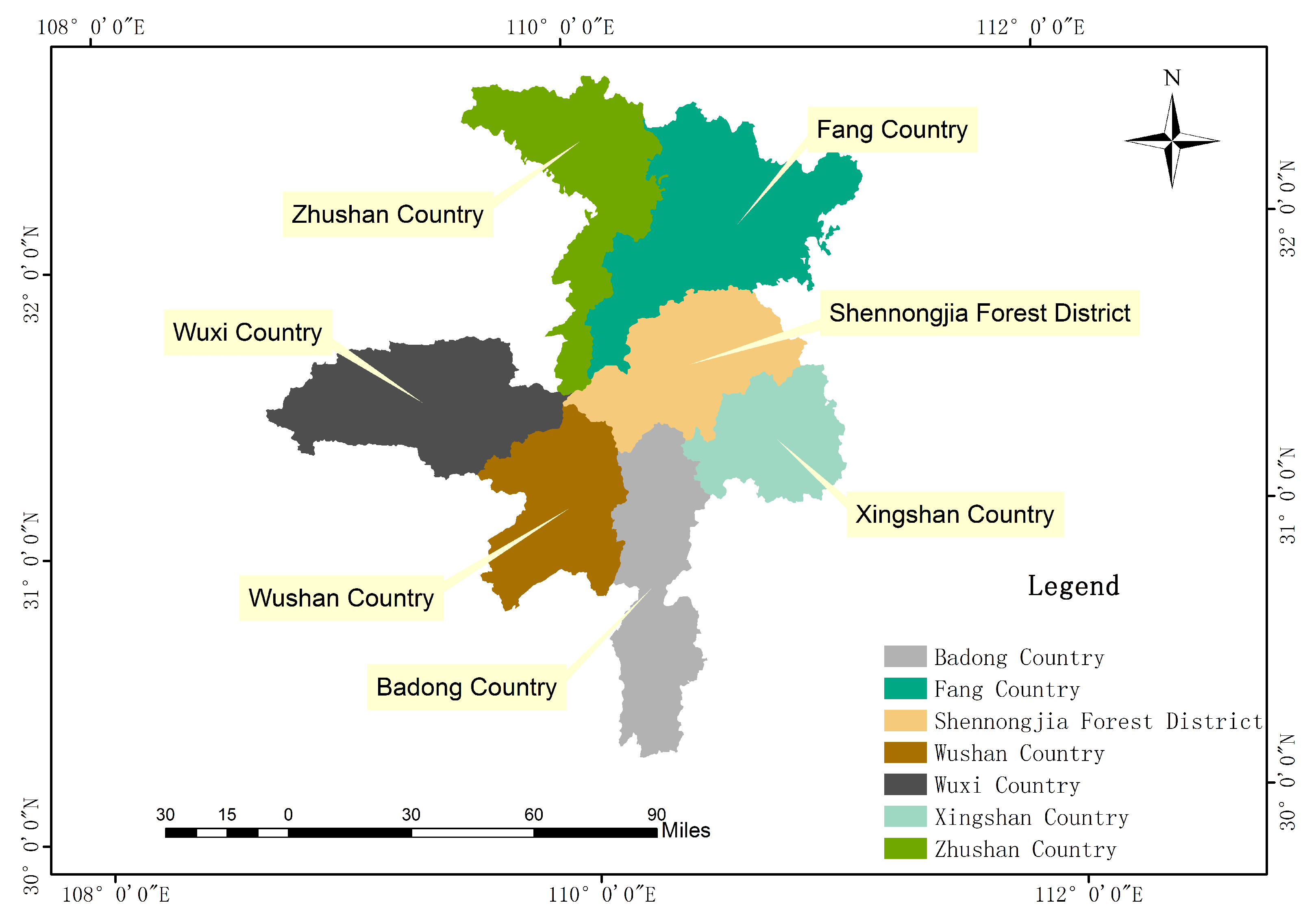

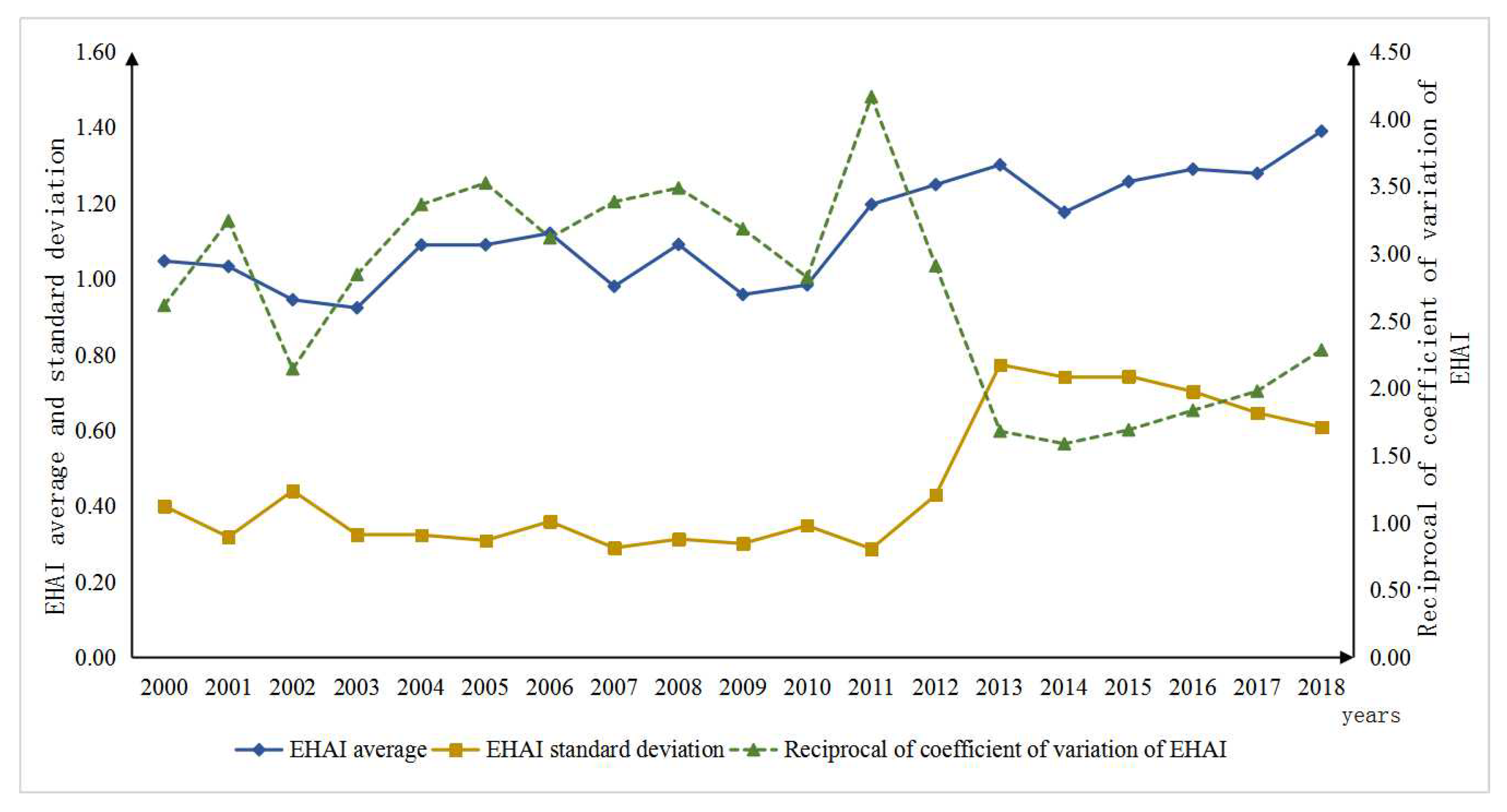
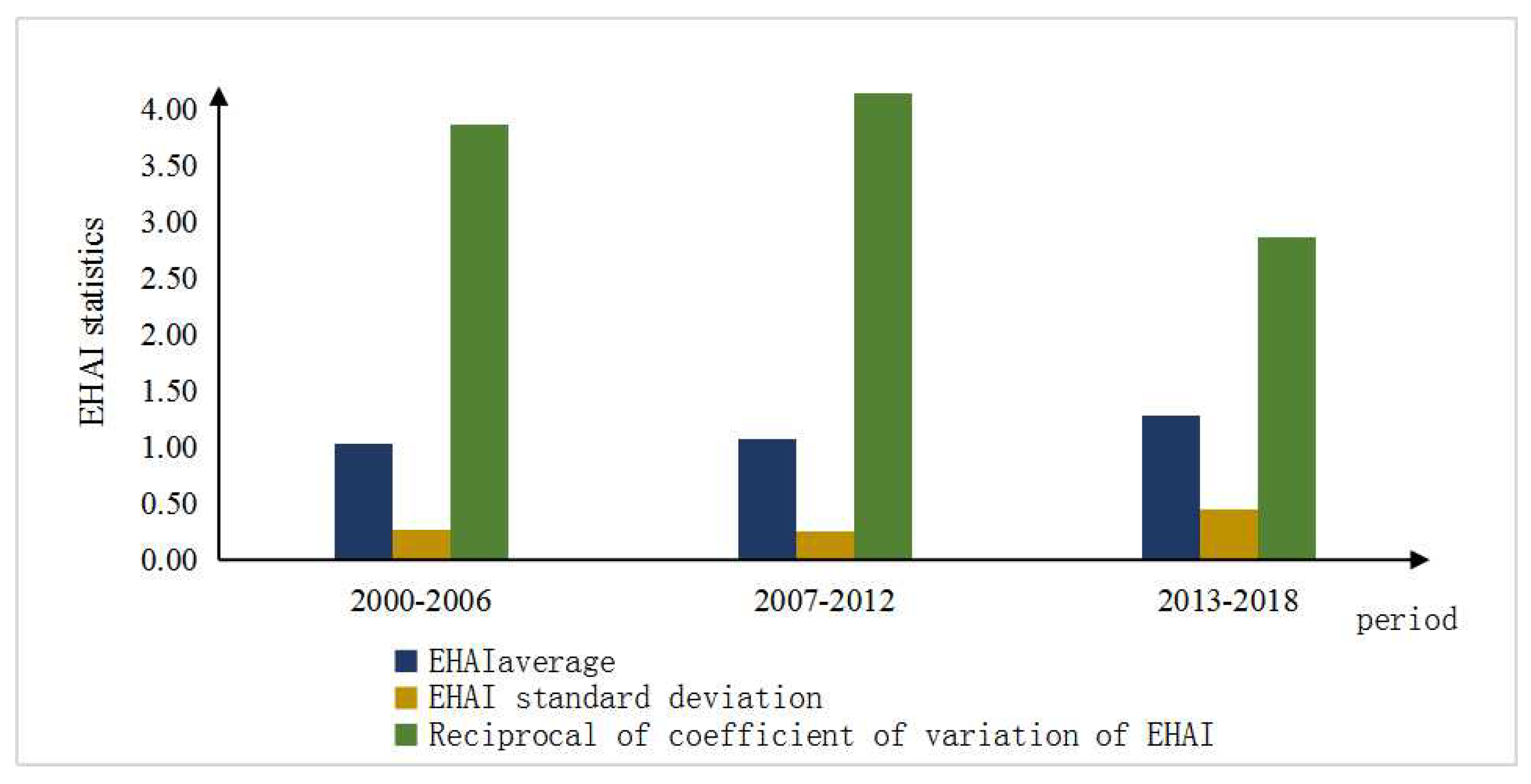

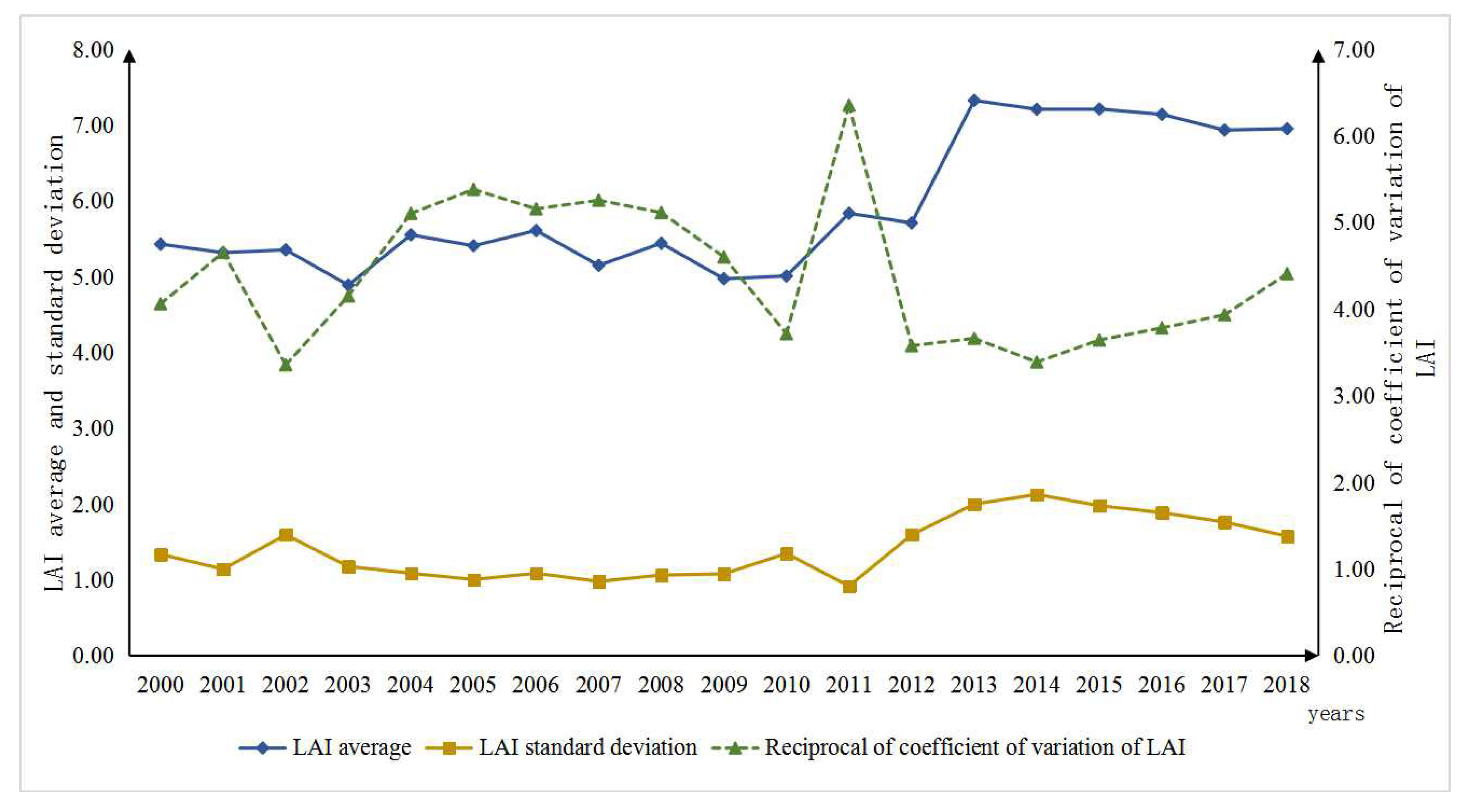

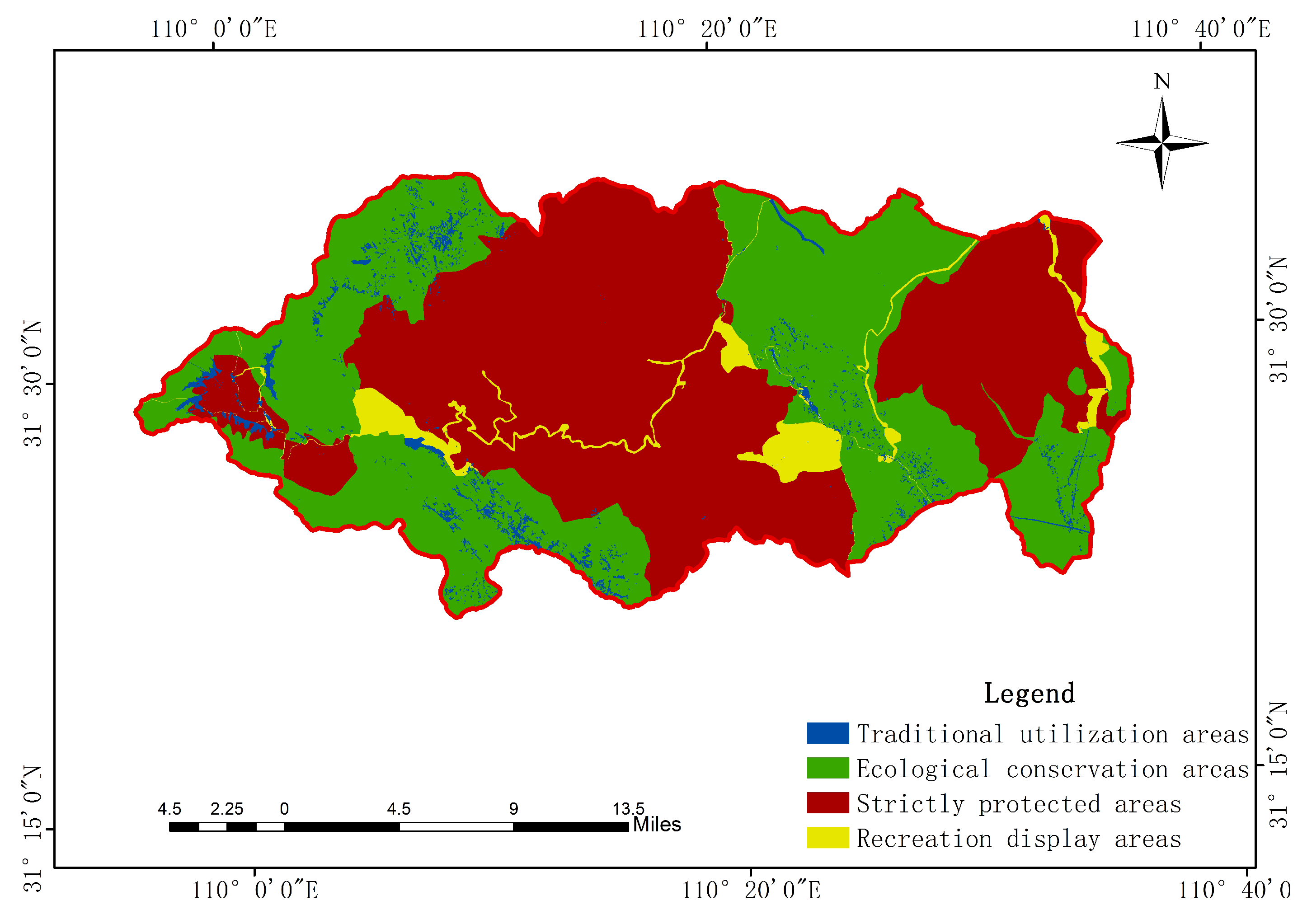
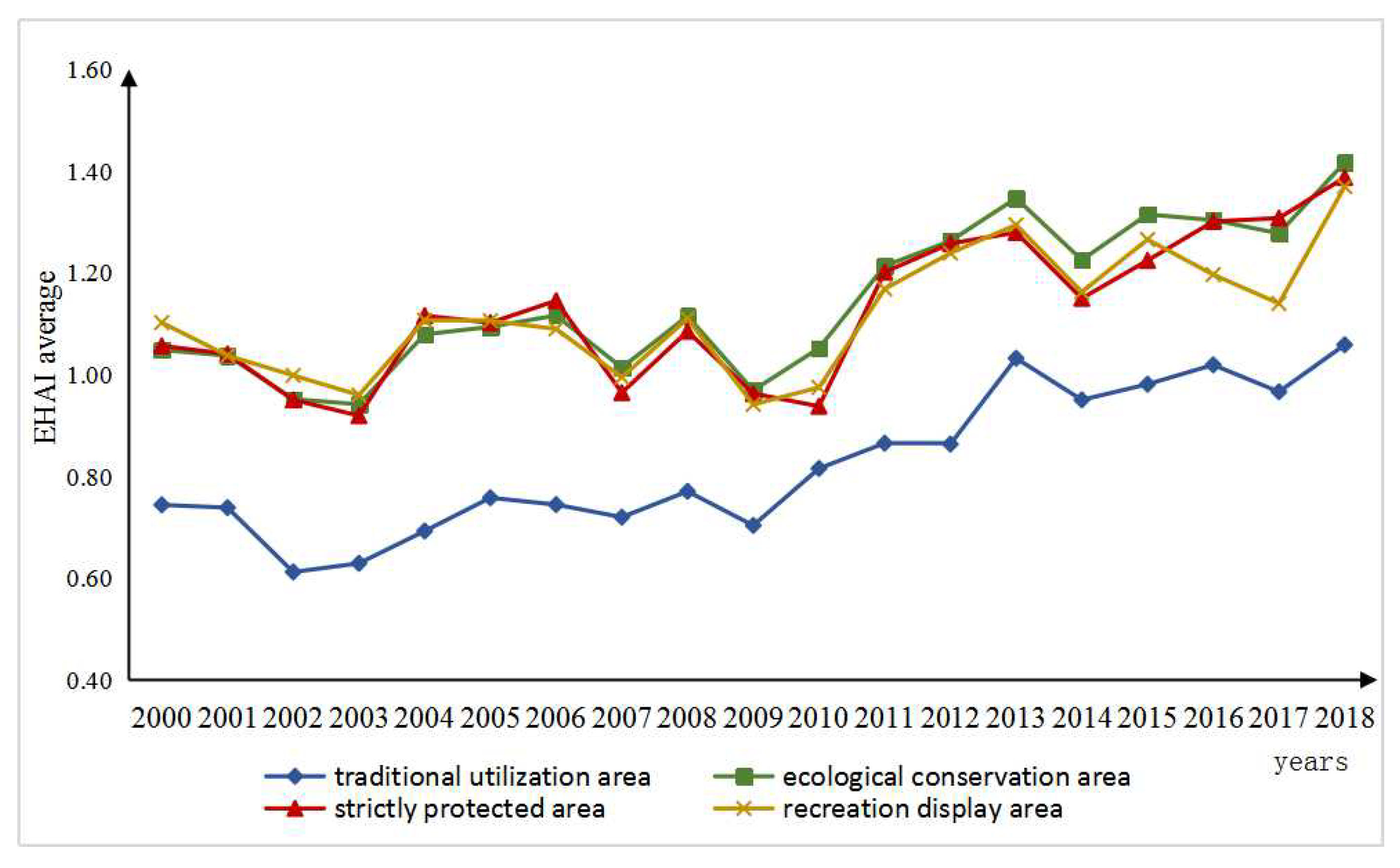
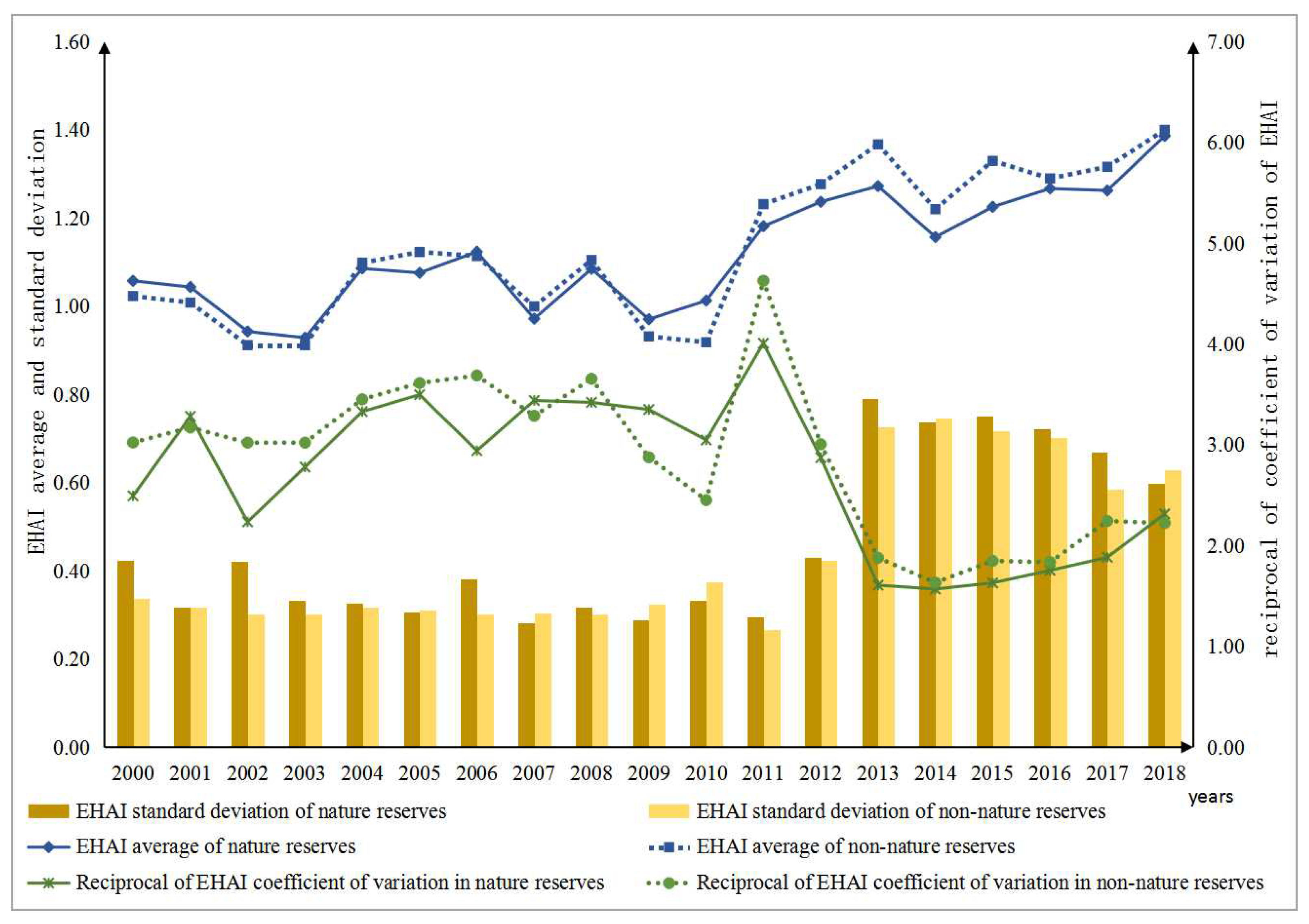
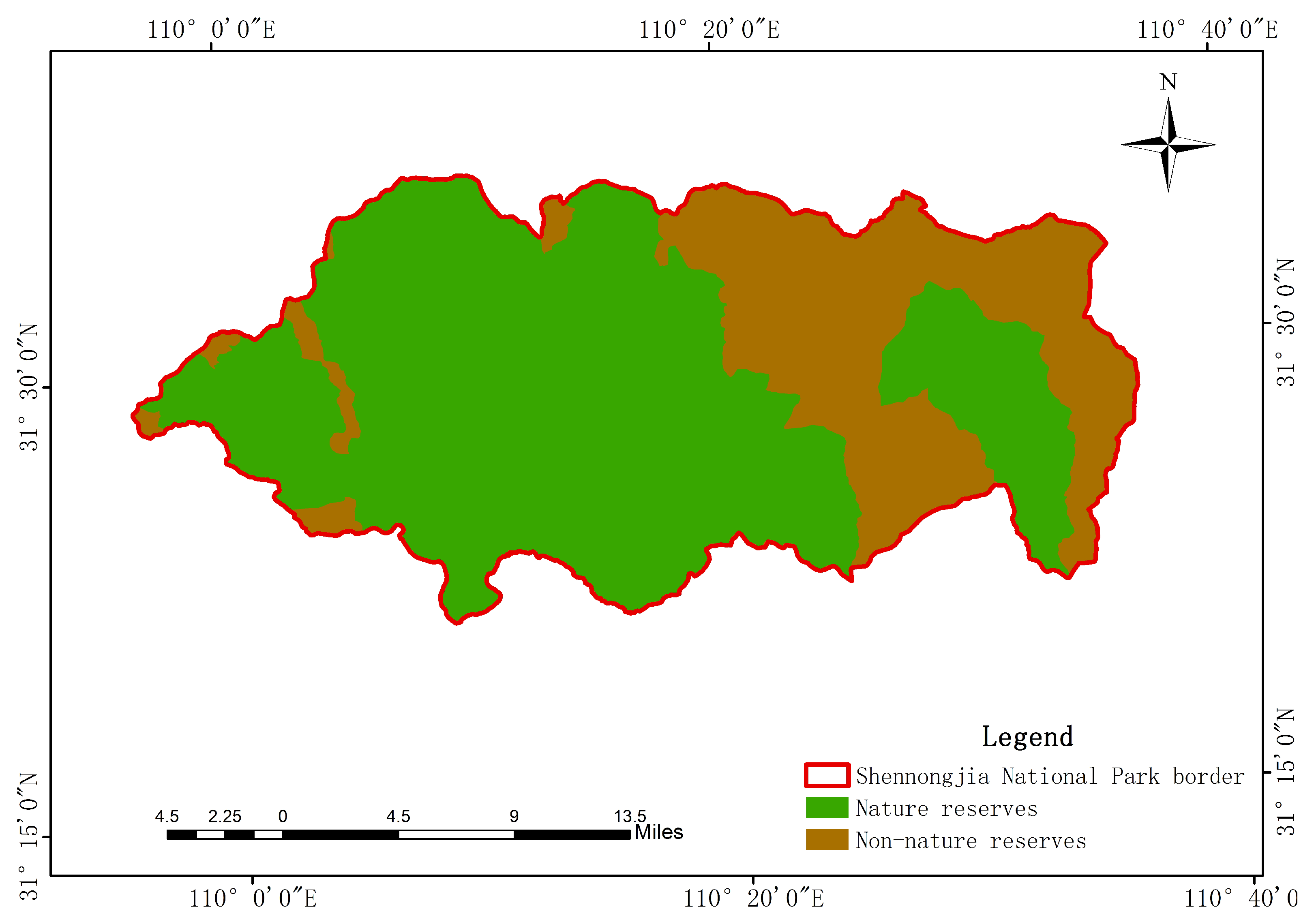
| Ecosystem | Sample Number | Accuracy (%) |
|---|---|---|
| Forestland | 450 | 97.9 |
| Grassland | 15 | 66.7 |
| Wetland | 5 | 80.0 |
| Farmland | 20 | 70.0 |
| Construction land | 5 | 60.0 |
| Bare ground | 5 | 10.0 |
| Total | 500 | 91.6 |
© 2020 by the authors. Licensee MDPI, Basel, Switzerland. This article is an open access article distributed under the terms and conditions of the Creative Commons Attribution (CC BY) license (http://creativecommons.org/licenses/by/4.0/).
Share and Cite
Wang, H.; Hou, P.; Jiang, J.; Xiao, R.; Zhai, J.; Fu, Z.; Hou, J. Ecosystem Health Assessment of Shennongjia National Park, China. Sustainability 2020, 12, 7672. https://doi.org/10.3390/su12187672
Wang H, Hou P, Jiang J, Xiao R, Zhai J, Fu Z, Hou J. Ecosystem Health Assessment of Shennongjia National Park, China. Sustainability. 2020; 12(18):7672. https://doi.org/10.3390/su12187672
Chicago/Turabian StyleWang, Huan, Peng Hou, Jinbao Jiang, Rulin Xiao, Jun Zhai, Zhuo Fu, and Jing Hou. 2020. "Ecosystem Health Assessment of Shennongjia National Park, China" Sustainability 12, no. 18: 7672. https://doi.org/10.3390/su12187672
APA StyleWang, H., Hou, P., Jiang, J., Xiao, R., Zhai, J., Fu, Z., & Hou, J. (2020). Ecosystem Health Assessment of Shennongjia National Park, China. Sustainability, 12(18), 7672. https://doi.org/10.3390/su12187672






